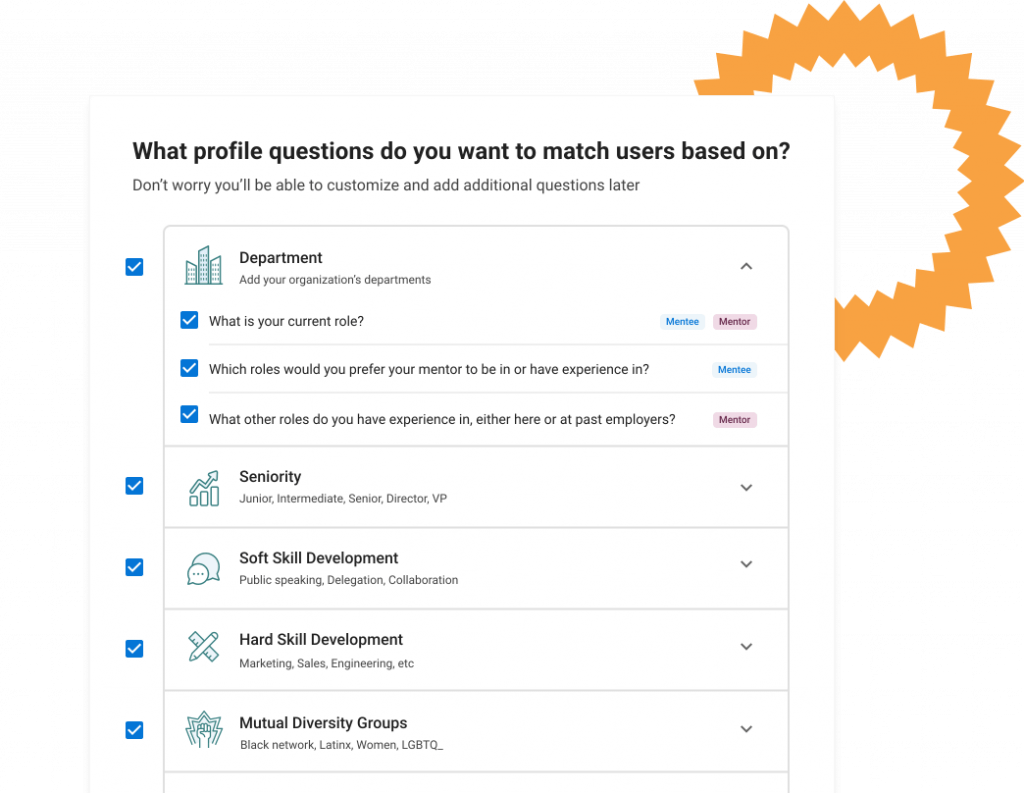A 2021 study by MentorcliQ found that 83% of employees who participated in a mentoring program said that it positively influenced their decision to stay with a company, and 88% of participants reported better productivity. This explains why 84% of Fortune 500 companies offer a formal mentoring program.
However, mentoring programs can be difficult to implement, especially when organizations don’t have the right technology in place or know how to use it. Mentoring software can help businesses effectively start and run mentoring programs. Here are a few tips for deploying it in a mentoring program.
If you don’t have a mentoring software solution in place yet, check out our Mentoring Software Product Selection Tool. It’s free, and in as little as five minutes, generates a customized list of mentoring platforms that will fit your business’s needs.
In this article...
Use the Mentor Matching Capabilities
Mentoring tools match mentors with mentees based on personality traits, career stage, and other factors. Many software solutions, like Together Mentoring Software and mentorcliQ, use AI algorithms to analyze mentee and mentor profiles and provide match scores, so mentees can choose from a range of potential mentors.

Administrators using Together can also include custom fields if they have other variables they want to base matches on.
While suggested matches aren’t the only way to pair members of a mentorship program, these matching capabilities increase the likelihood that a mentoring relationship will be successful. And when a tool can do the pairing for the mentorship program administrator, it saves that person time to focus on the more substantive aspects of the program.
Listen to: Tips for Leadership and Coaching to Guide the Next Generation of B2B Marketers
Track Goals and Progress
When mentorship pairs meet, they should use a platform to track SMART (Specific, Measurable, Achievable, Relevant, and Time-Bound) goals. For example, a new manager might set this goal: “I want to learn and implement three time-management strategies for my staff by the end of the quarter.” Setting SMART goals ensure that mentees are getting value out of their match and the program as a whole.
PLD Mentoring Platform, for instance, includes fields for participants to input their goals and any tasks they need to complete in order to accomplish them, as well as a spot for notes. Mentees and mentors should regularly update the goal progress, checking off tasks that have been completed or extending the deadline for those that need more time.
If the mentee isn’t progressing, it may be time to move them to a new mentor or reevaluate their goals.
Read more: How HR Can Implement Education that Supports All Employee Types
Communicate Frequently With Participants
Mentoring program administrators should check in regularly with participants to ensure that pairings are still working well. A mentee may be hesitant to tell their mentor that there’s a problem or things aren’t working out. A third-party check-in provides the mentee with a one-on-one opportunity to raise concerns or request a new mentor without fear of retaliation from their current mentor.
Platforms like Pushfar offer instant messaging capabilities, providing a secure, monitorable means of communication between mentors and mentees. Chronus includes a feedback portal, allowing admins to create participant surveys and speak directly with both mentors and mentees.
Generate and Review Reports Regularly
Reports are a great way to determine how successful a mentoring program is. Most mentoring platforms include customizable reports that track metrics such as:
- Participants’ goal progress
- Participants’ survey ratings
- Retention rates
- Promotion rates
These reports provide deep insights into how the program is performing and let administrators know which areas might need improvement.

Many mentoring tools like Qooper also include configurable dashboards, allowing administrators to get real-time data at a glance. They can select the most important metrics for their program and exclude extraneous information.
Mentorship Makes Employees Feel Valued
Mentorship programs are a great way to show employees that you’re invested in their talent, growth, and their future with the company. And feeling valued is a big part of talent retention. In fact, feeling under-appreciated is a key factor for 79% of employees who quit their jobs. If employees don’t think their current company values them, they’ll find a new organization that will.
Mentoring software can help engage and retain employees, especially when it’s customized to fit the needs of your business and mentoring program. Features like AI-based pairing algorithms, SMART goal tracking, participant feedback, and actionable reporting can help you ensure your employees are getting the most from their experience.
Read next: Need To Increase Employee Retention? Train Managers As Career Coaches

